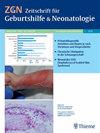[Two cases of skeletal ciliopathies in one family].
IF 0.6
4区 医学
Q4 OBSTETRICS & GYNECOLOGY
引用次数: 0
Abstract
Cilia are thin extensions on the cells of eukaryotic organisms. They are formed by a special protein transport mechanism - the intraflagellar transporter (IFT). The IFT consists of two proteins: complex A and complex B. Mutations in the genes of the IFT-A complex (IFT43, IFT121, IFT122, IFT139, IFT140, and IFT144) lead to the development of skeletal ciliopathies. These include Sensenbrenner, Jeune, and short-rib polydactyly syndrome [1,2]. We report two cases of different ciliopathies in a non-related family; both parents are heterozygous carriers of a pathogenic mutation in the IFT122 gene.
【同一家庭2例骨性纤毛病】。
纤毛是真核生物细胞上的薄延伸物。它们是由一种特殊的蛋白质运输机制-鞭毛内转运蛋白(IFT)形成的。IFT由两种蛋白质组成:复合体A和复合体b。IFT-A复合体(IFT43、IFT121、IFT122、IFT139、IFT140和IFT144)基因的突变可导致骨骼肌纤毛病的发生。包括Sensenbrenner、Jeune和短肋多指综合征[1,2]。我们报告两例不同的纤毛病在一个不相关的家庭;父母双方都是IFT122基因致病性突变的杂合携带者。
本文章由计算机程序翻译,如有差异,请以英文原文为准。
求助全文
约1分钟内获得全文
求助全文
来源期刊

Zeitschrift fur Geburtshilfe und Neonatologie
OBSTETRICS & GYNECOLOGY-PEDIATRICS
CiteScore
1.10
自引率
0.00%
发文量
166
审稿时长
>12 weeks
期刊介绍:
Gynäkologen, Geburtshelfer, Hebammen, Neonatologen, Pädiater
 求助内容:
求助内容: 应助结果提醒方式:
应助结果提醒方式:


